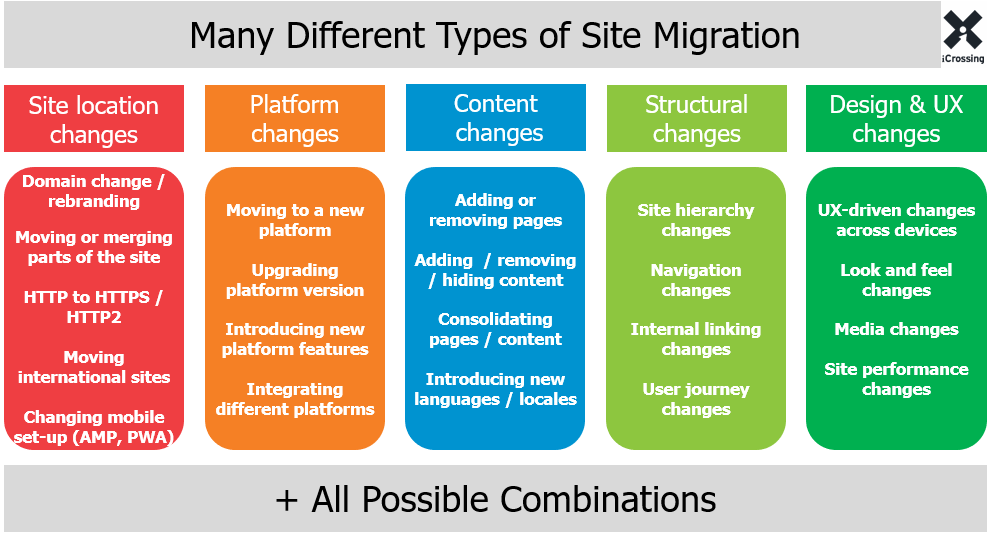Site Migration & SEO: How To Do It
By pinnacleadmin / 16 August 2021 / Websites / 6 min read
If you are planning a site migration, either changing domain or possibly implementing HTTPS, there are a few things you need to consider. There is nothing more detrimental to a brand’s current performance, than a poorly executed site migration.
What Is A Site Migration?
Site migration is a term effectively coined by SEO experts, describing an event where a website undergoes noticeable changes. Especially in areas that can directly affect search engine visibility.
Some of these changes can be:
- Site location
- Platform
- Structure
- Content
- Design
- UX
Most of the SEO world thinks that a site migration equals traffic and revenue loss. This is not the case. You can actually see a significant increase in growth after launching your site after a make over. The truth is, this is only possible if every step of the site migration is carefully planned and executed.

What Does A Successful Site Migration Look Like?
We can all imagine what an unsuccessful site migration looks like. Drops in traffic, with recovery after a 6 month period. Even loss in traffic with no recovery in sight.
But, what does a successful site migration look like?
There are a few things to consider here, such as the objectives, KPI’s and migration type. However, in most cases minimal visibility loss during the first few weeks and noticeable visibility growth.
A healthy HTTP to HTTPS migration looks something like this:
The above graphs show a significant increase in visibility and traffic growth to the site.
Common Site Migration Errors:
- Poor strategy
- Late involvement
- Poor planning
- Poor testing
- Lack of SEO/UX consultation
- Sow bug fixes
- Lack of resources/budget
- Under-estimating scale
A general rule of thumb is to not introduce too many changes at once, as this can become overly complex and developers tend to struggle narrowing down the issue. On the other side of the coin, leaving major changes for a later date can require additional resources.
That is why a carefully planned site migration is crucial.
If you have taken all possibilities into account, and know that a site migration is necessary (rebranding is needed, generation of press and links or moving to HTTPS), we have provided you with a thorough way of doing so below.
Some other things to consider when doing a site migration, is it is better to do this while your website is experiencing a slow period. You also need to crawl your site beforehand. This way you will have a complete list of URLs on your old site, as well as a benchmark to work from with the new site. Benchmarks are extremely important. Without one you won’t be able to accurately note any traffic drops, or additional errors that may have creeped in during the site migration process.
Site Migration Checklist:
Make sure you work out your project scope. Once that is done, make sure you have a fully formed project plan. Now you can start working on your pre-launch preparation.
Wireframes
Always review the prototype wireframes of your new site before carrying on with intense development. You need to be able to iron out any issues before large resources and budgets are poured into your next stages of development. Also, always involve your SEO team here, as they need to highlight any potential SEO and UX issues. From this stage, you can start getting your technical SEO specs in order.
Technical SEO
This is a document that showcases to developers how technical SEO should be implemented. Make sure that you cover all of your bases. The developers need to know everything, so nothing needs to be changed or reconfigured before the launch date.
- URL Structure
- Structured data
- Canonicals
- Meta data
- Main and secondary navigation
- Copy and headings
- Internal linking
- XML Sitemaps
- Hreflang
- Pagination
- Mobile setup
- Custom 404 pages
- Page loading times (for both mobile and desktop)
- Redirects
- Javascript,CSS and image files
Priority Pages
Always focus on the pages that really matter. Make sure you identify all indexable pages by crawling the legacy site, and making a note of your top performing pages.
Redirects
Possibly one of the most important facets of a website migration is the redirect implementation. Make sure this is done correctly, or your website’s rankings and visibility will definitely plummet.
Pre-Launch Checks
We are now at a point where we need to test the site before it is successfully launched. One thing to remember is to ensure that search engines cannot access the staging or test sites. The site should also only be accessible to specific whitelisted IPs.
If a site has been fully revamped and redesigned, make sure that the user journey hasn’t been affected. While you are doing this, you can review the site’s architecture, something which is very important when it comes to keywords ranking.
Access meta data and copy on the site, as well as all of the internal linking. Don’t forget the technical checks, such as structured data as well.
Once this is done, you need to make sure that the XML sitemap is perfect. It should only contain URLs you want to be indexed. When checking your sitemap, you need to make sure of the following items:
- It validates with no issues
- It does not contain more than 50,000 rows
- It is encoded as UTF-8
- Does not exceed 50mb when uncompressed
- No 4xx/5xx pages
- No soft 404s
- No canonicalised pages
- No noindex directives
Once the above has been done successfully, you can start counting down the days to the official launch of your new site.
Remember, even after the site has been launched, it needs to be monitored carefully. Make sure to review any crawl anomalies. Check your site speed.
How We Can Assist With Site Migration
Without taking SEO into account, we can guarantee a significant drop in traffic to your website and overall visibility in search engines. It can be really hard to recover after an unsuccessful migration, so it is best to do it right the first time.
No need to worry though, our team of highly skilled SEO experts are ready to take on any sized project, and efficiently assist you in migrating your website.
Ready to increase your search engine visibility and website traffic? Get in touch with us here.










